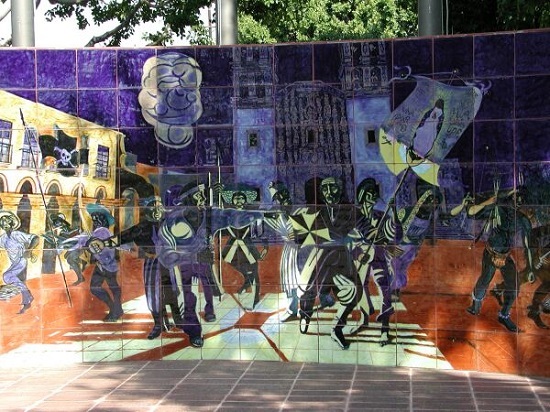The Mural Conservancy of Los Angeles offers informative and educational mural tours all over the city including, the Arts District, Venice and Santa Monica, Estrada Courts in Boyle Heights, and the Historic Downtown region including El Pueblo Historic Monument, Union Station, the 1984 Olympics freeway murals on the 101, and America Tropical by David Alfaro Siqueiros that is now being preserved by the City of Los Angeles and the Getty Conservation Institute. I joined the latter last week to get a better sense of the staggering amount of art that exists all over the city that is sometimes forgotten or overlooked. We first saw Blessing of the Animals by Leo Politi, an Italian-American who maintained a deep affection for the Mexican American community due to its exotic Mayan culture of the past and its Catholic ritual and devotion of the present.
Presented by Ian Robertson-Salt, office manager of the MCLA, currently pursuing a BFA at CSU Long Beach who is also a painter, illustrator, graphic designer, and muralist, the mural depicts a Catholic tradition of an animal procession and symbolizes a love for all creatures. Next we saw an excellent piece by Eduardo Carrillo done on three hundred individual pieces of tile, El Grito, the call to arms by Dolores Hidalgo in 1810 to call upon the Mexican populace to revolt against the Spanish Crown. Isabel Rojas-Williams, the executive director of the MCLA, provided a pedagogical interpretation of this work and this excellent artist who now has a museum in Santa Cruz dedicated to his memory and artwork.
Next we relocated to Union Station, where Milca Adamczyk, the Argentine-born ceramics artist, educator, and Mural Tour Coordinator of the MCLA provided an overview of the Dutch Colonial, Mission Revival, and Streamline Moderne architectural blend of the building and how it was built at the heart of the old Chinatown, and the City of Dreams mural by Richard Wyatt. This work portrays native Americans, settlers of the L.A. basin, and modern day Angelenos, which is accompanied by two permanent installations, a bench and aquarium that reflect and incorporate the flora and fauna of the L.A. River.
Nearby, there is a mural done by Terry Schoonhoven, "The Traveler," which reflects somewhat of an evolutionary time machine with images of an indigenous woman, a Spanish conquistador, a Yankee settler, a desperate actress and a modern-day backpacker, with a backdrop of city landmarks such as the destruction of the L.A. River, the Pico House, and City Hall.
While on our way to observe a tile mural by David Botello, he happened to be passing through Union Station and seized the opportunity to provide an overview in his own words. Botello is an original member of the East Los Streetscapers Collective, an active muralist since the Chicano Movement of the '60s and '70s, and he holds a Bachelor's degree in aerospace engineering and mathematics, and dual Master's degrees in fine arts and mechanical engineering. He has an extensive and impressive history and contributes greatly to the lineage of large-scale public artworks across the city.
On the 101 freeway we saw the newly restored piece by Frank Romero done during the 1984 Olympics, member of Los Four, the intellectual vanguard collective of Chicano artists active during the '70s and '80s, that included Carlos Almaraz, Roberto de la Rocha, Gilbert Lujan, and Judithe Hernandez, and who were primarily responsible for legitimizing Chicano art in the Anglo American mainstream. In 1974, LACMA exhibited the collective's work and further validated this type of work as an important contributor to a regional school of thought, and today most of the members are still active artists and well-respected throughout the international art community. Lastly, we visited the most significant mural in the entire city.
"America Tropical," painted by Siqueiros in 1932 was the ultimate symbol of social protest done on a grand-scale wall depicting the crucifixion of an indigenous male with an eagle representing the U.S. empire perched directly above, and guerrilla fighters emerging from both sides. It didn't win him any allies, and shortly thereafter when his visa expired, it wasn't renewed and he was forced to leave Los Angeles. He first painted "Workers' Meeting" at the Chouinard School, which displayed Black and Anglo workers coexisting in solidarity, however, racist authorities deemed the work intolerable and whitewashed it two weeks later. The legacy of our fragmented metropolis can be seen in artwork, urban planning, legislature, divided communities, and other areas of civil society. We all have a social responsibility to continue the defragmentation process if this city is to become a world-class city, and whatever your tools and strength may be, that should become your weapon of choice.
To join an MCLA art tour, you should become a member and take advantage of their mural tours and mixers visit here.
Photo courtesy of Rich Puchalsky
